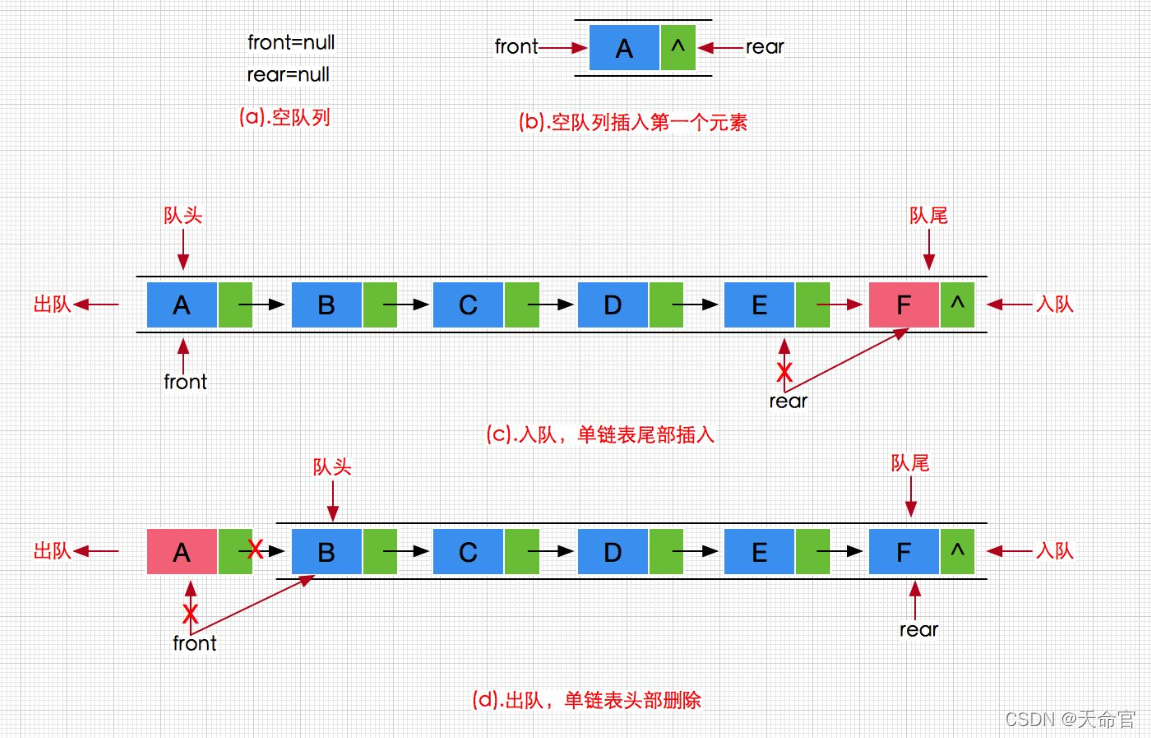本节目标
**学习栈的原理及基本实现 **
学习队列的原理及基本实现
栈:
一种特殊的线性表,其只允许在固定一端进行插入和删除元素操作。进行数据插入和删除操作的一端称为栈顶,另一端称为栈底。栈中的数据元素遵循后进先出 LIFO (Last In First Out) 的原则。
压栈:栈的插入操作叫做进栈,压栈,入栈,入数据在栈顶。
出栈:栈的删除操作叫做出栈。 出数据在栈顶。


实现
1.利用顺序表实现,即使用尾插 + 尾删的方式实现
2.利用链表实现,即头尾皆可
但相对来说,顺序表的实现更为简单一点,所以优先使用栈。
public class MyStack{
private int []array = new int [100];//建立数组大小
private int size = 0;//
public void push(int target){
array[size++] = target;//入栈将size位置的元素置为target;
}
public int pop(){
return array[--size];//出栈将size位置的元素出栈
}
public int peek(){
return array[size-1];
}
public boolean isEmpty(){
return size = 0;
}
public int size(){
return size;
}
}
队列(Queue)
队列: 只允许在一端进行插入数据操作,在另一端进行删除数据操作的特殊线性表,队列具有先进先出FIFO(First In First Out) 入队列;进行操作的一端称为队尾 出队列;进行删除操作的一端称为对头(Head/Front)

实现
队列也可数组和链表的结构实现更有一些,因为如果使用数组结构,出栈列在数组头上出数据,效率会比较低。

class Node{
int val;
Node next;
Node(int val, Node next){
this.val = val;
this.next = next;
}
Node(int val) {
this(val,null);
}
}
public class MyQueue{
private Node head = null;
private Node tail = null;
private int size = 0;
public void offer(int target){
Node node = new Node(target);
if(tail == null ) {
head = node;
}else{
tail.next = node;
}
tail = node;
size ++;
}
public int poll(){
if(size == 0) {
throw new RuntimeException("队列为空”);
}
Node olHead = head;
head = head.next;
if(head == null ) {
tail = null;
}
size--;
return olHead.val;
}
public int peek() {
if(size == 0 ){
throw new RuntimeException("队列为空”);
}
public boolean isEmoty() {
return size == 0;
}
public int size() {
return size ;
}
循环队列
实际上我们有时还会使用一种队列叫循环队列。如操作系统课程讲解生产者模型时可以使用循环队列。环形队列通常使用数组实现。

class MyCircularQueue {
public int[] elem;
public int front;
public int rear;
public MyCircularQueue(int k) {
this.elem = new int[k+1];要给到一个大一个值的数组
}
public boolean enQueue(int value) {
if( isFull()) return false;满的情况下 只能return false
elem[rear] = value;当前尾指针放入元素
rear = (rear+1) % elem.length;利用公式计算出下一个rear的位置
return true;
}
public boolean deQueue() {
if(isEmpty()) return false;空的情况下直接return false
front = ( front+1) % elem.length;利用公式计算出front 的位置
return true;
}
public int Front() {
if(isEmpty()){
return -1;
}
return elem[front];
}
public int Rear() {
if(isEmpty()) return -1;
int index = 0;
if(rear == 0){
index = elem.length-1;因为是 循环 所以只能是数组长度减一
}else{
index = rear-1; 常规操作 直接减一
}
return elem[index];返回
}
public boolean isEmpty() {
return front == rear; 当front和rear 处于同一位置是 返回
}
public boolean isFull() {
if((this.rear+1) % elem.length == front){这边就要用公式 rear的值只能与数组长度一致时才可
return true;
}
return false;
}
}
下面介绍比较常用的双端队列(deque)
双端队列(deque) 指允许两端都可以进行入队和出队的操作,double ended queue。说明元素可以从对头出队和入队,也可以从队尾出队和入队。
 **这一般的题目中会使用到双端队列进行解题、[Deque<> list = new LinkedList<>();] **
**这一般的题目中会使用到双端队列进行解题、[Deque<> list = new LinkedList<>();] **
在解题过程中可以使用一些方法进行对队列和栈的基础操作
方法E push()压栈E pop()出栈E peek()查看栈顶元素boolean emprt()判断栈是否为空错误处理抛出异常返回特殊值入队列add(e)offer(e)出队列remove()poll()队首元素element()peek()
头部/尾部
头部元素(队首)
尾部元素错误处理抛出异常返回特殊值抛出异常返回特殊值入队列addFirst(e)offerFirst(e)addLast(e)offerLast(e)出队列removeFirst()pollFirst()removeLast()pollLast()获取元素getFirst()peekFirst()getLast()peekLast()
基本操作题
括号匹配问题
用队列实现栈
用栈实现队列
实现一个最小栈
设计循环队列(在上文中介绍过)
class Solution {
public boolean isValid(String s) {
Stack<Character> stack = new Stack<>();创建一个栈
for(int i = 0; i< s.length(); i++){
char ch = s.charAt(i);循环遍历将其
if(ch =='(' || ch == '{' || ch == '['){如果存在其中一种括号
stack.push(ch);放入栈中
}else{
if(stack.empty()){
return false;没有直接return false
}
char top = stack.peek();出栈顶元素
if(top =='(' && ch == ')' || top == '{' && ch =='}' || top == '[' && ch == ']'){ 当top 值与 ch 值相同时 出
stack.pop();
}else{不相同 return false
return false;
}
}
}
if(!stack.empty()){ 最后判断 栈中还有元素 说明匹配的括号多 无法全部配对成功
return false;
}
return true;
}
}
class MyStack {
private Queue<Integer> pu1;
private Queue<Integer> pu2;
public MyStack() {
pu1 = new LinkedList<>();
pu2 = new LinkedList<>();
}
public void push(int x) {
if(!pu1.isEmpty()){队列1 不为空 直接放入
pu1.offer(x);
}else if(!pu2.isEmpty()){队列2 不为空 直接放入
pu2.offer(x);
}else{
pu1.offer(x);
}
}
public int pop() {
if(!pu1.isEmpty()){队列1 不为空
int size = pu1.size()-1;
for(int i = 0; i< size; i++){
pu2.offer(pu1.poll()); 将队列1 中元素挨个放进 队列2 中
}
return pu1.poll();
}
if(!pu2.isEmpty()){队列2 不为空
int size = pu2.size()-1;
for(int i = 0; i< size; i++){ 循环为 队列2 长度-1
pu1.offer(pu2.poll()); 将其放入队列1 中
}
return pu2.poll();
}
return-1;
}
public int top() {
if(empty()) return -1;
if(!pu1.isEmpty()){
int val = -1;
int size = pu1.size();
for(int i = 0; i<size; i++){将队列1中元素放入2中
val = pu1.poll();
pu2.offer( val);
}
return val;
}
if(!pu2.isEmpty()){
int val = -1;
int size = pu2.size();
for(int i = 0; i<size; i++){将队列2中放入1中
val = pu2.poll() ;
pu1.offer( val);
}
return val;
}
return -1;
}
public boolean empty() {
return pu1.isEmpty() && pu2.isEmpty();
}
}
class MyQueue {
public Stack<Integer> stack1;
public Stack<Integer> stack2;
public MyQueue() {
stack1 = new Stack<>();
stack2 = new Stack<>();
}
public void push(int x) {
stack1.push(x);直接放入元素
}
public int pop() {
if(empty()) return -1;
if(stack2.empty()){
while(!stack1.isEmpty()){栈2不为空栈1为空的情况下
stack2.push(stack1.pop());将栈1中元素放入2中
}
}
return stack2.pop();
}
public int peek() {
if(empty()) return -1;
if(stack2.empty()){栈1不为空栈2为空的情况下
while(!stack1.isEmpty()){
stack2.push(stack1.pop());将栈1中元素放入2中
}
}
return stack2.peek();
}
public boolean empty() {
return stack1.isEmpty() && stack2.isEmpty();
}
}
class MinStack {
private Stack<Integer> stack;
private Stack<Integer> minstack;
public MinStack() {建立两个栈进行存放
stack = new Stack< >();
minstack = new Stack<>();
}
public void push(int val) {
stack.push(val);
if(!minstack.empty()){
int top = minstack.peek();最小栈不为空的情况下
if( val <= top ){将给出的值与最小栈的栈顶元素进行比较
minstack.push(val);小则将其放入
}
}else{
minstack.push(val);
}
}
public void pop() {
int pro = stack.pop();
if(!minstack.empty()){
int tmp = minstack.peek();
if( tmp == pro ){这是在其相同的情况下
minstack.pop();最小栈要出元素
}
}
}
public int top() {
return stack.peek();
}
public int getMin() {
return minstack.peek();获取最小元素直接将最下栈的栈顶元素返回
}
}
本文中所出现的题目全来自力扣原题 !!!
由于初次接触博客希望各位前辈给出宝贵的意见 谢谢!!!
版权归原作者 天命官 所有, 如有侵权,请联系我们删除。